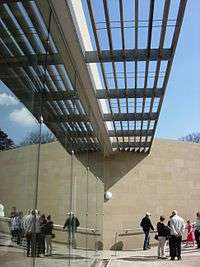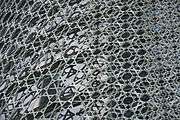Brise soleil

A basic brise soleil at the Underground gallery at the
Yorkshire Sculpture Park. This photo was taken at noon in April, a little after the
vernal equinox. Note how the top of the glazing is in shade. As the passage of summer continues, the noon shading on the glass will be greater.
Brise soleil, sometimes brise-soleil (French pronunciation: [bʁiːz sɔlɛj], plural, "brise-soleil" (invariable), or "bris-ole", from French, "sun breaker"), is an architectural feature of a building that reduces heat gain within that building by deflecting sunlight.[1]
Architecture
Brise-soleils can comprise a variety of permanent sun-shading structures, ranging from the simple patterned concrete walls popularized by Le Corbusier in the Palace of Assembly to the elaborate wing-like mechanism devised by Santiago Calatrava for the Milwaukee Art Museum or the mechanical, pattern-creating devices of the Institut du Monde Arabe by Jean Nouvel.
In the typical form, a horizontal projection extends from the sunside facade of a building. This is most commonly used to prevent facades with a large amount of glass from overheating during the summer. Often louvers are incorporated into the shade to prevent the high-angle summer sun falling on the facade, but also to allow the low-angle winter sun to provide some passive solar heating.[2]
Gallery
| I. The movable Burke brise soleil on the Quadracci Pavilion of the Milwaukee Art Museum closes at sunset |
| Detail of north facade of Gustavo Capanema Palace |
|
See also
References
- ↑ Peter Borden, Gail; Meredith, Michael, eds. (2012). Matter: Material Processes in Architectural Production. Routledge. p. 330.
- ↑ Tolson, Simon (2014). Dictionary of Construction Terms. CRC Press. p. 40.
External links

.jpg)



